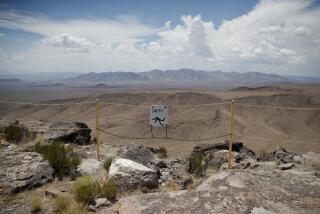ENVIRONMENT : Seeking a Foster Home for Nuclear Waste : Negotiator finds some interest in taking a little radioactivity off his hands for a while.
- Share via
WASHINGTON — By the end of the decade, the U.S. government will find itself responsible for the disposal of high-level radioactive waste from nuclear plants--without a permanent facility to put it in.
In the scramble for a temporary storage site, while legal battles rage over a permanent one, the federal government has found unexpected interest from 14 Indian tribes, four Western counties and an Alaskan village that could benefit handsomely if they can persuade their communities to take on the role of temporary caretakers of the nation’s most dangerous waste.
Led by the Mescalero Apache tribe of New Mexico, the communities have applied for grants of as much as $100,000 to see if there is enough interest to proceed with studies of specific sites and begin serious negotiations with the federal government.
This has not always been a popular idea: In Grant County, N.D., the commissioners’ acceptance of a grant has led to their recall. Leaders of the Chickasaw tribe of Oklahoma had second thoughts and declined their grant after it was approved. So did the Sac and Fox tribe in Oklahoma.
But by this spring, David Leroy, the nation’s nuclear waste negotiator, had awarded four grants. Twelve more applications were pending. The deadline, which had been March 31, was extended another 90 days.
The Mescalero Apaches, who filed their Phase I application in October, 1991, were the first to apply for a Phase II grant, which could amount to as much as $2.8 million for detailed studies of a possible temporary storage facility for spent nuclear fuel rods on their reservation. Leroy, a former lieutenant governor of Idaho who began the search for a temporary storage site in the fall of 1990, says he remains optimistic that an interim resting place can be found for the material that the government hopes to ultimately bury in a deep geologic repository.
“I believe there are jurisdictions in this country where the public will choose to understand, and, therefore, accept the possibility of this mission,” he said. “It’s a very difficult job, but I believe in the ability of the people to make decisions.”
BACKGROUND: During the four decades in which nuclear reactors have produced electricity, used fuel rods have been stored in deep pools of water inside the reactor buildings. But now the pools are reaching capacity, and some utilities already have begun moving the spent fuel rods into heavily lined casks on their property.
Although residual radiation diminishes dramatically in the first few years, the fuel assemblies must be sealed away from the environment for 10,000 years.
In 1982, Congress ordered the U.S. Department of Energy to develop a repository for permanent disposal of the material. Promising utilities that the government would take possession of the waste no later than Jan. 31, 1998, it also directed the DOE to study and propose a site for an interim facility.
In 1987, Congress created the office of nuclear waste negotiator, charging it to find a voluntary host for the temporary storage.
While the search for an interim location goes forward, a 10-year scientific assessment is under way to determine whether Yucca Mountain, Nev., 100 miles northwest of Las Vegas, is suitable as a permanent repository for as much as 70,000 tons of radioactive waste.
Under the present law, however, an interim storage complex may not be built until the Nuclear Regulatory Commission issues a license for construction of a permanent repository. It will be at least the year 2001 before the studies on Yucca Mountain are finished.
Therefore, with the 1998 deadline looming, there is mounting pressure to begin work on the temporary facility.
OUTLOOK: Leroy has told congressional staffers that he expects two or three of every 10 applicants for the initial study grants to proceed to Phase II.
Meanwhile, Leroy and his top lieutenants are traveling more than 100,000 miles a year in search of new applicants. With his growing list of applicants willing to accept the first exploratory grant, Energy Department officials believe he has a chance of creating an atmosphere of competition for the complex because of the economic windfall--primarily from new jobs--that would result for the host community.
But, says Leroy: “We continue to maintain that it is OK to say no, that the process concentrate first on the sensitive areas of health, safety and the environment.”
While he professes to find satisfaction in his uphill quest (“I’ve got the best job in America,” he insists), Leroy says his commitment is to create a process that can succeed.
More to Read
Sign up for Essential California
The most important California stories and recommendations in your inbox every morning.
You may occasionally receive promotional content from the Los Angeles Times.












